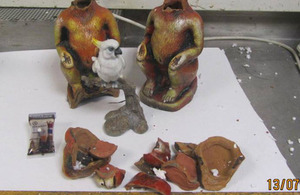Border Force warning to smugglers and organised crime groups
Images released show the extreme lengths criminals will go to.

Opium in monkey statues
Carpets, confectionary and a chapatti oven are just some of the ways organised crime gangs have tried to smuggle drugs into the UK.
Releasing a range of images showing the lengths criminals will go to in their attempts to circumvent border controls, Border Force Director General Sir Charles Montgomery, warned would-be smugglers that Border Force officers have the skills and technology to catch them.
In 2012-13, Border Force met or exceeded its targets for the seizure and detection of Class A drugs. A total of 2.4 tonnes of cocaine and 445 kg of heroin were seized during this period.
Border Force Director General, Sir Charles Montgomery, said:
“As these pictures show, smugglers are trying increasingly sophisticated methods and we need to stay one step ahead. Fortunately our officers have seen virtually every trick in the book.
“Border Force is the first line of defence in protecting the UK from serious and organised crime. The skill and experience of our officers helps keep drugs and other illegal goods out of the country and off our streets.”
Opium monkeys
Last month an attempt to smuggle opium into the UK hidden inside two monkey statues was stopped by Border Force officers at the Coventry International Postal Hub. Each of the statues contained 1kg of the drug with a total street value of £20,000.
The class A drugs had been concealed within a consignment of statues flown to the UK from India. When Border Force officers examined the package they found three ceramic figurines – two monkeys and a bird. Bags containing a black tar-like substance, which later tested positive as opium, were found inside the hollow centres of both the monkey statues.
Cocaine wheelchair
A man from North West London was sentenced to three and a half years, in June 2012, for attempting to smuggle around £370,000 worth of cocaine into the UK hidden inside his wheelchair.
Daniel Roque Hall had flown to Heathrow Airport from Peru, via Paris Charles de Gaulle Airport. Swabs were taken from his wheelchair which showed to be positive for traces of drugs. An x-ray then revealed almost 3 kilos of high purity cocaine concealed within the removable leather seat of his wheelchair.
Drugs in rugs
In April this year, Border Force officers at Manchester Airport seized a large amount of heroin hidden inside a shipment of carpets.
The seizure officers became suspicious of a 46-piece consignment of hand-made knotted carpets that had arrived from Peshawar in Pakistan via Abu Dhabi. More than 50 kilos of heroin worth around £5 million was found making the haul one of the biggest ever drug seizures at Manchester Airport.
Cigarette waistcoats
In May 2013, two male passengers flying from Lithuania were stopped at Leeds Bradford Airport when officers became suspicious of their bulky and ill-fitting jackets. The men were carrying almost 30,000 cigarettes including thousands concealed in specially adapted waistcoats.
Iguanas in socks
In February this year two women flying from the Bahamas were stopped at Heathrow with 13 endangered iguanas stuffed into socks and hidden in their suitcase. Twelve survived the journey but one died in transit. San Salvador rock iguanas are such a rare species that there are only a few hundred left in existence. The two Romanian women were jailed for a year.
In 2012/13 Border Force officers made over 690 seizures under CITES (Convention on International Trade in Endangered Species of Wild Fauna and Flora) regulations, up from 516 the year before. Among the seizures were 326 ivory items and 93 live animals.